Beetle infestation
The western US and British Columbia are currently experiencing an infestation of bark beetles that are a potentially destructive force in forest ecosystems.

The western US and British Columbia are currently experiencing an infestation of bark beetles that are a potentially destructive force in forest ecosystems. By boring into the bark the beetles release gases from the trunks. However, up until now, it was not known how these insect attacks affect the atmosphere.1
The emissions of volatile organic compounds (VOCs) were collected from bark beetle infested and healthy lodgepole pine trees and from sites with and without active mountain pine beetle infestation using sorbent traps. The sorbent traps were then extracted with hexane and the extracts separated and detected using gas chromatography–mass spectrometry (GC–MS). Canister samples were also collected and analysed. Bark beetle infested trees were found to release up to 20 times more VOCs than healthy trees. It was also found that ß-phellandrene emissions correlated with bark beetle infestation.
The team concluded that an increase in the quantity of VOC emissions is a useful tool for identifying bark beetle infestation and for indicating when VOCs are at a level that can harm both the environment and human health.
1. Kara E. Huff Hartz et al., Environmental Science & Technology, DOI: 10.1021/es204205m
This story originally appeared in The Column. Click here to view that issue.
Removing Double-Stranded RNA Impurities Using Chromatography
April 8th 2025Researchers from Agency for Science, Technology and Research in Singapore recently published a review article exploring how chromatography can be used to remove double-stranded RNA impurities during mRNA therapeutics production.
The Effect of Time and Tide On PFAS Concentrations in Estuaries
April 8th 2025Oliver Jones and Navneet Singh from RMIT University, Melbourne, Australia discuss a recent study they conducted to investigate the relationship between tidal cycles and PFAS concentrations in estuarine systems, and offer practical advice on the sample preparation and LC–MS/MS techniques they used to achieve the best results.












